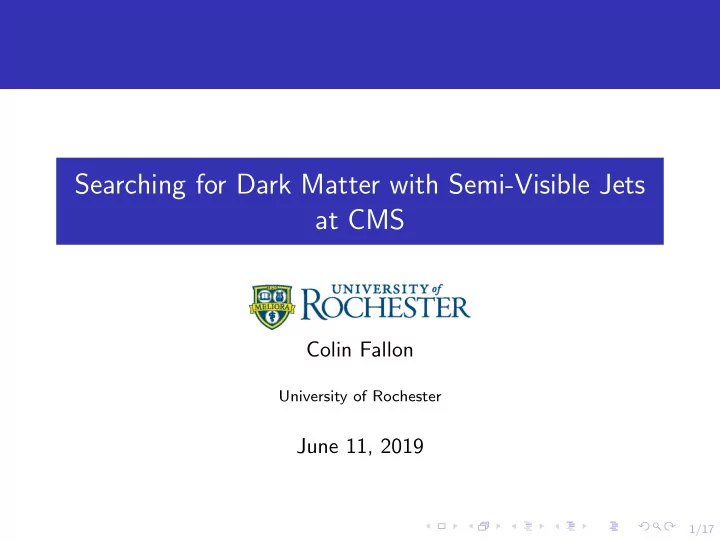

Searching for Dark Matter with Semi-Visible Jets at CMS Colin Fallon University of Rochester June 11, 2019 /Pictures/URlogo.png 1/17
Semi-Visible Jets Analysis Team Presented on behalf of the Semi-Visible Jets Analysis Team: University of Rochester Colin Fallon Aran Garcia-Bellido Fermi National Accelerator C.L. Keane Tan Laboratory Universitaet Zuerich Kevin Pedro V. Daniel Elvira Annapaola De Cosa Steven Mrenna Giorgia Rauco University of Maryland University of Bristol Sarah Eno Eshwen Bhal Henning Flacher Benjamin Krikler /Pictures/URlogo.png 2/17
1 Introduction 2 Dark Matter and Hidden Valley Hidden Valley Theory Semi-Visible Jets 3 The Analysis A BDT for Jet Tagging The Bump Hunt /Pictures/URlogo.png 3/17
Searching This presentation will deal mostly This analysis is a with the theory that allows for Work-In-Progress. Semi Visible Jet production at These plots are not official. hadron colliders anyway, but Please do not distribute towards the end there are some these slides outside this MC plots that are technically conference. WIP. /Pictures/URlogo.png 4/17
What is Dark Matter? Practically - Anything that isn’t Standard Model matter Experimentally - Astronomical observations Theoretically - Pick your poison! SuperSymmetry! It Doesn’t Exist! (Entropic Gravity, and others...) Hidden Valley /Pictures/URlogo.png 5/17
2 Minute Primer on Hidden Valley Dark Matter The realm of Dark Matter is a second gauge group ( G v ) that exists independently of the SM gauge group ( G SM ). All SM particles are neutral in the G v gauge, while all HV particles are neutral in the G SM gauge. /Pictures/URlogo.png 6/17
Connecting SM to HV If the two gauge groups are independent, how can SM colliders produce DM? To ‘bridge the gap’ between SM and HV, a messenger particle is postulated that is charged under both gauges. This messenger, hereafter referred to as Z ′ , can be produced by and can decay into both SM and HV particles. ↔ Z ′ ↔ /Pictures/URlogo.png 7/17
What could the HV sector look like? If G v is made up of a QCD-like gauge, then dark matter would be comprised of dark quarks which form dark hadrons. Here we have a realativly simple sector of two dark quarks and dark gluons to bind them. → /Pictures/URlogo.png 8/17
Side Note: Whats a Jet!? Jet: a cone of hadrons produced from the hadonization of quarks and gluons Jets exist because of color confinement of QCD. Jets are not detected but This is a Jet (yellow) that reconstructed through jet has many particles (red) and clustering algorithms . is ‘inline’ with the Missing Transverse Energy (green) /Pictures/URlogo.png 9/17
How does that HV sector produce Semi-Visible Jets? SM quarks interact and produce a Z’. The messenger does as its name implies and decays into a pair of dark quarks. These initial dark quarks hadronize, and form two dark mesons. Heavy dark matter mesons would decay through ‘dark’ hadronization; light dark mesons are stable. /Pictures/URlogo.png 10/17
How does that HV sector produce Semi-Visible Jets? Dark hadronization will produce more Z’ messengers and light dark mesons. These Z’ messengers can then decay into more HV mesons or back into SM hadrons. SM hadrons will hadronize. This continues until all that remains are light dark mesons and SM hadrons. /Pictures/URlogo.png 11/17
Thats how SemiVisible Jets are produced, but how can we find them? /Pictures/URlogo.png 12/17
Understand what they look like Event Display Plot of Signal MC at GEN level Standard cut-based analysis Reality is much more grim, with to select events and filter low ∆ φ events being popular in backgrounds, but that’s not all our backgrounds good enough... /Pictures/URlogo.png 13/17
Tag them with a Boosted Decision Tree Form of Machine Learning Finds a set of 1D cuts to identify signal and background In this case, we’re using the BDT to tag individual jets as a SVJ or not. Girth, τ 21 , τ 32 , SoftDrop Mass, min ∆ φ , Major and Minor Axis, ptD, energy correlation functions, ptdrlog, particle type energy /Pictures/URlogo.png fractions, b -tagging variable 14/17
Hunt for a Bump Used often for resonant searches. Typically use an invariant mass, where it be dijet mass, jet-lepton mass, diphoton mass... However, the dijet mass of SVJs doesn’t really look too nice for a bump hunt... /Pictures/URlogo.png 15/17
Hunt for a better Bump! Instead, we use the transverse mass variable: m T = � � p Tjj · � m 2 m 2 jj + p 2 Tjj � � jj + 2( E T − � E T ) /Pictures/URlogo.png 16/17
Hidden Valley Dark Matter 1 SemiVisible Jets 2 BDT to identify Semi-Visible Jets 3 Bump Hunt in m T to find Z’ Thank you! Any Questions? 1 Matt Stassler and Echos of a Hidden Valley at Hadron Colliders 2 Tim Cohen and Mariangela Lisanti for SVJ phenomenology papers /Pictures/URlogo.png 3 CMS Analysis Note AN-19-064 17/17
Recommend
More recommend